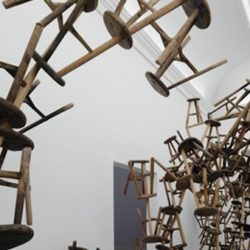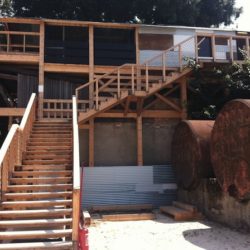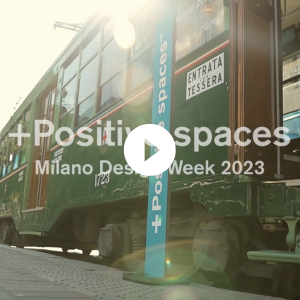There are a few instances, where there is a deep interaction between a work of art and the surrounding space and, by enclosing also the observer, they create and “organic system”. Sometimes, going beyond the site-specific concept, art even seems to invade architecture; some art installations are architectures themselves. The latest Venice Biennale and St. Moritz Art Master offered a few interesting instances.
The so-called site-specific is a work of art, that relates with the surroundings and refers to the local identity and history. But how do we define those installations that prevail over architecture, they appropriate it and distort its spatiality?
For example Rudolf Stingel’s estranging installation unfolds over the atrium and both upper floors of Palazzo Grassi in Venice; a space of over 5,000 square meters carpeting with the pattern of an oriental rug used as background for paintings and photographs.
Since the ‘90s Stingel places the “carpet” at the core of his poetics; the carpet bears witness to the passage of time and people and is also a source of inspiration, with its variety of typologies and textures, for successive series of paintings, it is a medium through which painting relates to its architectural context. Interested in the redefinition of the meaning of “painting” and of its perception; it transports our imaginary to the Orient or to Sigmund Freud’s study in Vienna (the exhibition is open until December 31st).
In Venice too, still proposed by the perceptive François Pinault, the first large space opening the exhibition “Materia Prima” at Punta della Dogana, is an occasion to rethink spaces and modify the perception; the chaotic setting by Ryan Trecartin e Lizzie Fitch that “sedecrates” Tadao Ando’s minimal architecture is a mix of structures, outdoor fittings, installations, reinvented furniture units and projections at the visitor’s disposal, who can use and benefit from them. Please touch them!
Another monumental project on the occasion of 55a Biennale d’Arte a Venezia, is “è A Remote Whisper” by the Portuguese artist Pedro Cabrita Reis “penetrating” into the 700 sqm of the first floor of Palazzo Falier with a precarious and hand-made installation that combines aluminum, glass, and fluorescent fixtures, drawings, paintings, and photos; inviting the viewer to engage in a path of random trajectories through the space, thus building an intricate perception of the piece (the exhibition is open until December 31st).
Last but not least, the great Ai Weiwei, who affected us in Venice with the famous Straight (another collateral event of Biennale at Zuecca Project Space), a sort of poignant memory of what happened – the 2008 Sichuan earthquake, the deaths of 5196 children caused by the collapse of the school- 150 ton of rusted i steel rebar recovered from the earthquake site now wind up in uneven, calm waves to infect the whole environment with a feeling of agony and pain. (Ai Weiwei, Disposition, until 15 September, Giudecca & Sant’Antonin, Venice, presented by Zuecca Project Space in collaboration with Lisson Gallery).
At Giardini della Biennale another artwork by Ai Weiwei, Bang, invades the Deutscher Pavillion (curated by Susanne Gaensheimer, in a “twin exchange” with France) the artist assembled 886 three –legged wooden traditional Chinese antique stools: an explosion, an expansive rhizomatic stucture, a rampant proliferating organism to criticize the extreme modernization in China.
Don’t forget another site-specific by Ai Weiwei at St.Moritz Art Masters , the monumental Iron Tree that filled up the “minimal” architecture of the Reformierte Kirche consists of 99 pieces of dead trees from different species collected from different areas around southern China; the trunks are held toghether by oversized screws and nuts.
The crazy, hanging and polychromic architecture Relay by the Swiss artist Kerim Seiler, is still visible on the roof of the Criystal Hotel in St. Moritz (a part of Blackbox Project): a small home-atelier-shelter to lodge and inspire foreign artists ((in 2013 the South-African Gerald Machona and the Chinese Li Li).
Art takes shake, sizes and identities of architecture also at Padiglione Georgia at 55a Biennale d’Arte di Venezia; Kamikaze Loggia (curator Joanna Warsza), is a parasitic extension to an old building in the Arsenale.This living typology peculiar to Tbilisi, made of terraces and additional rooms, turns into an atelier and temporary exhibiting space for seven artists, who want to bring out the critical potential of these unaffected architectures. (Biennale until November 24th).
Text by Renata Sias, editor of WOW! Webmagazine
Captions
1 Rudolf Stingel, Untitled (St. John the Baptist), view at Palazzo Grassi Venezia. Photo: Stefan Altenburger. Private collection. Courtesy of the artist.
2 Materia Prima, installation by Ryan Trecartin / Lizzie Fitch, Punta della Dogana Venezia.
3 A Remote Whisper, Pedro Cabrita Reis, Palazzo Falier Venezia. Photo JoãoErrand-Pcr Studio.
4 Straight, Ai Weiwei. Installation view, Zuecca Project Space,Venice, 2013 (Courtesy, the artist and Lisson Gallery)
5 Iron Tree, Ai Weiwei, St.Moritz Art Masters 2013.
6 Bang, Ai Weiwei, German Pavillion at 55 International Art Exhibition La Biennale di Venezia.
7 Relay, Kerim Seiler, Criystal Hotel St Moritz, St.Moritz Art Masters 2013.
8 Kamikaze Loggia, Pavillion of Georgia at 55 International Art Exhibition La Biennale di Venezia.


















